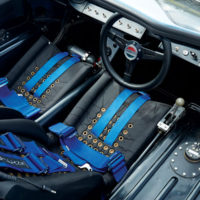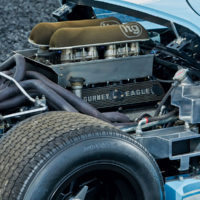SCM Analysis
Detailing
| Vehicle: | 1969 Ford GT40 |
| Years Produced: | 1964–69 (all variants) |
| Number Produced: | 105 |
| SCM Valuation: | $7,650,000 |
| Tune Up Cost: | $300 for basic oil/tappets service; a day on a rolling road with a box of Weber jets is up to $2k |
| Chassis Number Location: | Tag on right side of tub behind seat |
| Engine Number Location: | Top of block in front of left cylinder head (if you’re lucky) |
| Club Info: | Automobile Club de L’Ouest |
| Website: | http://www.lemans.org |
| Alternatives: | 1963–67 Chaparral 2, 1966–67 Ferrari 330 P3/412 P, 1968 Ford P68/F3L |
| Investment Grade: | A |
This car, Lot 10, sold for $3,478,486 (£2,508,000), including buyer’s premium, at Gooding & Co.’s Geared Online auction on June 18, 2021.
The realization of why the GT40 was such a good long-distance weapon and a poorly considered street car took only a few miles to sink in.
Things were looser back in the 1990s, and I had been detailed to deliver DWC 8G, the Ford Mk III press car, from Bryan Wingfield’s workshops in Essex to one of the first Festivals of Speed at Goodwood. The car immediately made me comfortable and impressed with its air of indestructibility, tracking straight and handling faithfully, as if it would have happily taken me to Scotland. Or Spain. Or the finish line at Le Mans.
Even a Mk III isn’t very practical, though. Wingfield’s parting shot, after a very brief briefing whose very briefness imbued confidence that this wasn’t a car that needed coddling, was to tell me to use the wider truck lane when crossing the Queen Elizabeth II bridge. Then one is able to open the door wide enough at the toll booth, he explained, to hand the coins out of the roof. You see, the postage-stamp windows don’t open very far, even on the road version.
It worked a treat, though the inevitable “Nice replica, mate” came when I was giving it a splosh at the service station. A real GT40 on the road has always been a unicorn.
Today DWC 8G is still a Ford press car, and it now goes everywhere in a covered transporter. On that day, however, when I got to Goodwood, there was nobody obvious to hand over the car to. So, I parked it on the lawn next to some other GT40s and left it there, with the keys in it.
Yesterday and today
You probably wouldn’t dare do that now, such is the awe in which these cars are held. Walking around this perfect example at the auction viewing was another special moment for me. Was there ever a hornier shape devised?
Peering down into its cabin took me back in time, complete with seat covers eyed for ventilation and the angled speedometer way over on the left. In classic GT40 configuration, this car retains the gated gearchange on the right sill (where the Mk III I drove had a center gearchange), a further attempt to tame it for “everyday” use. Chassis-wise, the only real difference between the Mk III and the others is extra holes for the coolant pipes, such that they don’t have to run through the cockpit.
What he said
GT40 historian Ronnie Spain makes an interesting point about the authenticity of this car in his 2007 authentication letter: “GT40 P1085 by being ‘chassis only supplied’ did not have a set of parts supplied on it, or with it, when new. So the long overdue final build-up of 1085 is not something where original configuration and specification can be worried about being adhered to. There has been no original configuration or specification. Instead GT40 P1085 is a blank canvas waiting for the paint — and the parts — to be applied. It really is a unique opportunity for whoever buys this car to build it up as they would like it without fear of detracting from originality.”
If this sounds like a bit of a dodge, consider what Spain next proposes: “I can’t help wondering what would happen if it was suddenly discovered that a 38th Ferrari 250 GTO chassis had been built and turned up still as a bare chassis. Would it be dismissed as not being a real car as it had not been built up in period, or would there be a frenzy of back-stabbing to try and get hold of the car at any cost? No contest. Same thing exactly with GT40 P1085 in my opinion. A Ford GT40 that has survived uncompleted for almost 40 years? I still can’t believe it.”
Indeed. This car is indisputably the real thing, with a real chassis number, even if the car wasn’t actually completed until 12 years ago. Since then, it appears to have done very little apart from its participation in the 2009 Tour Auto. It remains in superb condition, with an almost complete spare body still in unpainted gel coat.
After its debut, 1085 was sold by restoration expert Lee Maxted-Page, who’s looked after it since. “We sold P1085 to the previous owner in 2011 and stored it here in the interim,” he confirms.
The market speaks
The money paid was a bit more than Gooding’s slightly conservative estimate, but this was the chance of a lifetime. Compare this with the car built up largely from real parts collected over the years by Terry Drury, who worked on the original GT40 project and previously owned two real ones (1005 and 1073). That couldn’t claim to have a real chassis, though in terms of nuts and bolts, it was just as good as 1085. It sold at Silverstone’s auction in May 2020 (its second attempt) for $411,504 (SCM# 6932794).
This is one of those times when the money is almost irrelevant. The holy grail of GT40s, one of the three ’66 Le Mans winners, sold for $9,795,000 at RM Sotheby’s Monterey in 2018 (SCM# 6877236), which represents the top of the market. But being able to secure the last real GT40 looks like a helluva deal, at this or any price. ♦
(Introductory description courtesy of Gooding & Company.)




